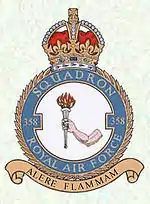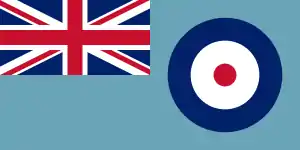No. 358 Squadron RAF
No. 358 Squadron RAF was a Bomber and Special duties squadron of the Royal Air Force flying with South East Asia Command from 1944 to 1945.
| No. 358 Squadron RAF | |
|---|---|
 Official Squadron crest for No. 358 Squadron RAF | |
| Active | 8 November 1944 – 19 November 1945 |
| Country | |
| Branch | |
| Role | Bomber squadron Special duties |
| Part of | No. 231 Group RAF, South East Asia Command[1] |
| Motto(s) | Latin: Alere flammam (Translation: "To feed the flame")[2][3] |
| Insignia | |
| Squadron Badge heraldry | An arm embowed, holding in the hand a torch[3] The torch represents the spirit of freedom and the arm upholding it the role played by the squadron[2] |
| Squadron Codes | TA (Nov 1944 – Dec 1944)[4][5] |
| Aircraft flown | |
| Bomber | Consolidated Liberator |
| Trainer | Vickers Wellington |
History
The squadron was formed on 8 November 1944 at Kolar, India with personnel of the disbanded 1673 Heavy Conversion Unit. Its role was as a heavy bomber unit flying the Consolidated Liberator. The squadron performed only one bombing mission on 13 January 1945, bombing Mandalay and by then flying from Digri. Thereafter the squadron role changed to a special duties squadron,[2][3] starting operations as such in the night from 22 to 23 January 1945.[2][3] On 10 February 1945 the squadron moved to Jessore. For the rest of the war the squadron dropped agents and supplies to resistance groups in Japanese-held territory. After the Japanese surrender the squadron then dropped supplies to POW camps and repatriated released prisoners. It was disbanded on 21 November 1945 at Bishnupur.[3]
Aircraft operated
| From | To | Aircraft | Version |
|---|---|---|---|
| November 1944 | December 1944 | Vickers Wellington | Mk.X |
| December 1944 | November 1945 | Consolidated Liberator | Mk.VI |
Squadron bases
| From | To | Base |
|---|---|---|
| 8 November 1944 | 3 January 1945 | RAF Kolar, Karnataka, British India |
| 3 January 1945 | 10 February 1945 | RAF Digri, Bengal, British India |
| 10 February 1945 | 19 November 1945 | RAF Jessore, Bengal, British India |
| 19 November 1945 | 21 November 1945 | RAF Bishnupur, Bengal, British India |
References
Citations
- Delve 1994, p. 84.
- Moyes 1976, p. 234.
- Halley 1988, p. 386.
- Bowyer & Rawlings 1979, p. 96.
- Flintham & Thomas 2003, p. 107.
- Halley 1988, p. 387.
- Jefford 2001, p. 90.
- Jefford 2001, pp. 268–271.
Bibliography
- Bowyer, Michael J.F.; Rawlings, John D.R. (1979). Squadron Codes, 1937–56. Cambridge, UK: Patrick Stephens Ltd. ISBN 0-85059-364-6.
- Delve, Ken (1994). The Source Book of the RAF. Shrewsbury, Shropshire, UK: Airlife Publishing. ISBN 1-85310-451-5.
- Flintham, Vic; Thomas, Andrew (2003). Combat Codes: A Full Explanation and Listing of British, Commonwealth and Allied Air Force Unit Codes since 1938. Shrewsbury, Shropshire, UK: Airlife Publishing Ltd. ISBN 1-84037-281-8.
- Gwynne-Timothy, John R.W. (1991). Burma Liberators: RCAF in SEAC. Toronto, Ontario, Canada: Next Level Press. ISBN 1-895578-02-7.
- Halley, James J. (1988). The Squadrons of the Royal Air Force & Commonwealth, 1918–1988. Tonbridge, Kent, UK: Air-Britain (Historians) Ltd. ISBN 0-85130-164-9.
- Jefford, C.G. (2001). RAF Squadrons, a Comprehensive record of the Movement and Equipment of all RAF Squadrons and their Antecedents since 1912 (2nd ed.). Shrewsbury, Shropshire, UK: Airlife Publishing Ltd. ISBN 1-85310-053-6.
- Moyes, Philip J.R. (1976). Bomber Squadrons of the RAF and their Aircraft. London: Macdonald and Jane's (Publishers) Ltd. ISBN 0-354-01027-1.
- Oughton, James D.; Hamlin, John; Thomas, Andrew (2007). The Liberator in Royal Air Force and Commonwealth Service. Tonbridge, Kent, UK: Air-Britain (Historians) Ltd. ISBN 978-0-85130-362-8.
